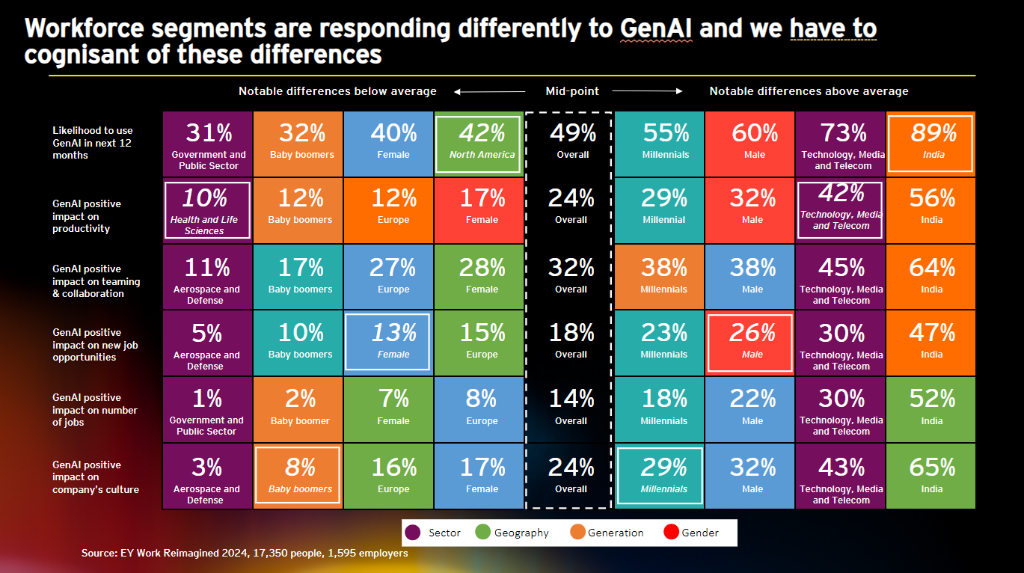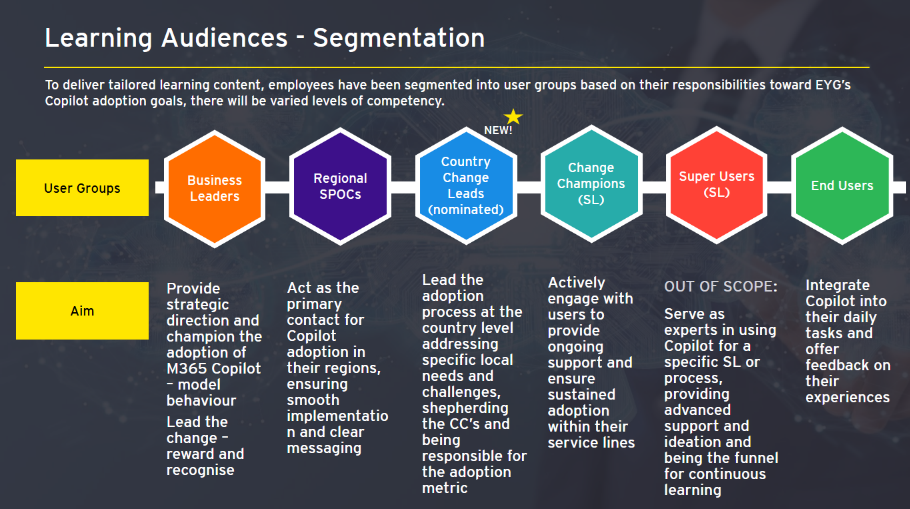Building AI skills at scale
)
By now, most organisations have begun or are advancing on their AI journeys. However, there’s a shared challenge that has emerged – and that’s a shortage of skilled talent that is limiting effective implementation and transformation. It’s not necessarily that these organisations have taken a wrong turn, it’s just that GenAI is so new, that the skills don’t exist [1] and most organisations don’t have the structured training and upskilling programmes to close this gap.
In the World Economic Forum’s 2025 Future of Jobs report [2], 77% of organisations see reskilling and upskilling of the existing workforce to work more effectively alongside AI, as the most anticipated workforce strategy for dealing with AI disruption.
While the desire exists to build foundational AI skills, fluency, mindset and confidence, some significant barriers remain. The top barriers [3] when it comes to AI adoption are estimating and demonstrating AI value and a lack of talent/training.

effective learning programme when not everyone is responding in the same way to AI [5], with differences across sectors, geographies, generations and genders. You’ll see from our breakdown (above) that there are some notable differences when it comes to demographics.
As EY’s Global Learning and Development Leader, my role is to create a culture of continuous learning and development by fostering curiosity, creating opportunities for our people to thrive, and nurturing tomorrow’s business leaders. We recently refreshed our employee value proposition: ‘Shape your future with confidence,’ which is about empowerment, as well as how EY’s legacy and scale can give people the confidence to succeed. Most notably, this promise is shaped by the three things EY people told us matter most to them: building skills for the future, a greater focus on wellbeing and being part of an inclusive culture. Our AI learning journey isn’t new, but as we’ve refreshed and scaled our programs, we’ve made them about meeting people wherever they’re at. Now, we’ve created a foundation of AI learning that’s helping our clients do the same. Here are some of the most important things we’ve learned along the way:
Fostering a learning culture
First things first, learning has to move from being seen as a compliance or optional activity, to becoming deeply embedded within how we undertake work. A big part of that shift is prioritising the time to learn AI skills. When we asked EY employees what they wanted more of, they said it was time. Specifically, time to spend on learning and developing new skills, coaching, investing in their own careers, mentoring, building professional networks and being involved in their communities. So, it was critical for us to find more ways to embed learning and personal development into daily routines without increasing demands on their time. One solution was the introduction of Thrive Time – dedicated and protected time for them to focus on what’s most important to them.
We also developed our own tool similar to ChatGPT tool called EYQ. Immediately, we began seeing the positive impact that these kinds of tools have on productivity and the ability for people to focus on high-value work. The success of the approach was evidenced by the high user adoption rate of EYQ, which stands at over 81%, with more than 85 million prompts processed in just nine months [6].
Creating exceptional learner experiences
Today’s employees are looking for experiences that are personalised and seamless. Instead of developing AI learning as an add-on, systems should be connected and should utilise AI to give a clear view and equitable learning opportunities to all learners. At EY, learners can pursue AI credentials through our global upskilling program, EY Badges, (which helps us build and apply skills at scale) or extend their learning all the way to an EY Master’s degree, offered in collaboration with Hult University.
Last year, we delivered more than 60 hours of learning per person. With our range of learning options, we saw an uptick in AI upskilling, with over 85% of all EY employees (340k people) completing our ‘AI Now’ e-learning course and more than 70k AI EY Badges completed to date and a further 60k in progress. These badges including learning paths, but also require demonstrated application of the learning.
We’ve also seen a skills shift that’s evident in My Career Hub, an AI-driven tool that shows us who’s open to new roles and what skills they bring to the table. It helps our people map their career aspirations and identify skill gaps and growth areas. The tool is enabling us to deploy people in a very strategic way that serves our clients, but also keeps people engaged and excited about their next opportunity.
Providing collaborative support
When it comes to learning and skills development, the key is ensuring everyone has access to great learning opportunities, and that you’re delivering the right mix of skills, resources & sponsorship, leveraging the right mix of external vendors and ensuring clear governance to enable the strategy and plan to be delivered.
I mentioned the idea of meeting employees where they are, to support more effective implementation and productivity. We have worked to segments our audiences to ensure we provide the right solutions, recognising their varying stages of AI maturity and needs (see figure 2 below).
We know people learn best through doing, so they’re presented with a combination of micro-challenges, context-sensitive support, contests and storytelling that support the natural discovery behaviours of early adopters and prompt action by fast followers. Using recognition tools like leaderboards can help create new cultural norms that reward and encourage collaboration behaviours that ultimately drive regular adoption.

More organisations are establishing their own academies to conduct in-house upskilling and reskilling to meet specific skill demands internally. Building on our EY.ai Academy, we’ve begun offering comprehensive AI learning to clients, leveraging a range of training delivery approaches and building on our own proven internal content.
Knowing your own technology
Ethan Mollick, Wharton School Professor, said (after talking to many firms), “I have come to believe a key factor in successful AI adoption is whether the executive team actually experiments with AI to try to get work done themselves. Those who do tend to feel urgency and push for transformation.”
This is a trend we see as well. In order for an organisation to find success with AI, learning needs to be prioritised from the top down and the technologies should be understood and used by leaders, who ideally become ambassadors. At EY, we ran a comprehensive AI learning program that was specifically designed for our partners to expand their AI literacy. These learners then showed their teams, not just an understanding of AI’s potential for our business, but how AI was enhancing their experiences at work.
If your organisation’s AI adoption and implementation isn’t advancing as desired, examining your training and upskilling programs is a great place to start. Building AI skills at scale is a learning journey that will inevitably have triumphs and setbacks and will need to continuously evolve to keep up with the pace of change. When we get it right, upskilling for these critical and future-focused skills is a powerful way for us to differentiate our organisations, where people can continue to learn and develop – empowering both individuals and the business to thrive. Democratising our learning and building AI confidence for positive human impact will ultimately help us unlock new sources of value and purposeful growth.
Resources
[1] World Economic Forum, 2025 Future of Jobs report, #1 barrier, Lack of skills to support adoption (50%)
[2] World Economic Forum, 2025 Future of Jobs report
[3] Gartner: AI in the enterprise survey (N= 632, leaders highly involved in AI)
[4] Curious Advantage podcast S6, Eps9, 2024, Alexia Cambon (Microsoft), GenAi Power users with mindset of curiosity and persistence
[5] EY Work Reimagined 2024, 17,350 people, 1,595 employers
[6] Case study: How EY transformed itself with AI | EY - Global
Simon Brown 
Global Learning and Development Leader at EY
Simon is responsible for building a strong and equitable learning foundation for 400,000 EY people in more than 150 countries. Don't miss Simon's session at the Learning Technologies 2025 Conference, taking place on Thursday, 24 April at 13:55 - 15:05 BST.


)
)
)
)
)
)
)
)
)
)
)
)
)
)
)
)
)
)
)
)
)
)
)
)
)
)
)
)
)
)
)
)